The visual novel landscape is vast, often filled with tales of romance and slice-of-life scenarios. However, for those seeking experiences that venture far beyond the conventional, Saya No Uta: The Song Of Saya stands as a chilling recommendation. Emerging from Nitroplus in 2003, this title quickly distinguished itself. Instead of heartwarming high school romances, Saya no Uta: The Song of Saya plunges into a world of unsettling grotesqueries from the very beginning. As someone who appreciates narratives that defy expectations, discovering The Song of Saya early in my visual novel journey was truly a transformative experience.
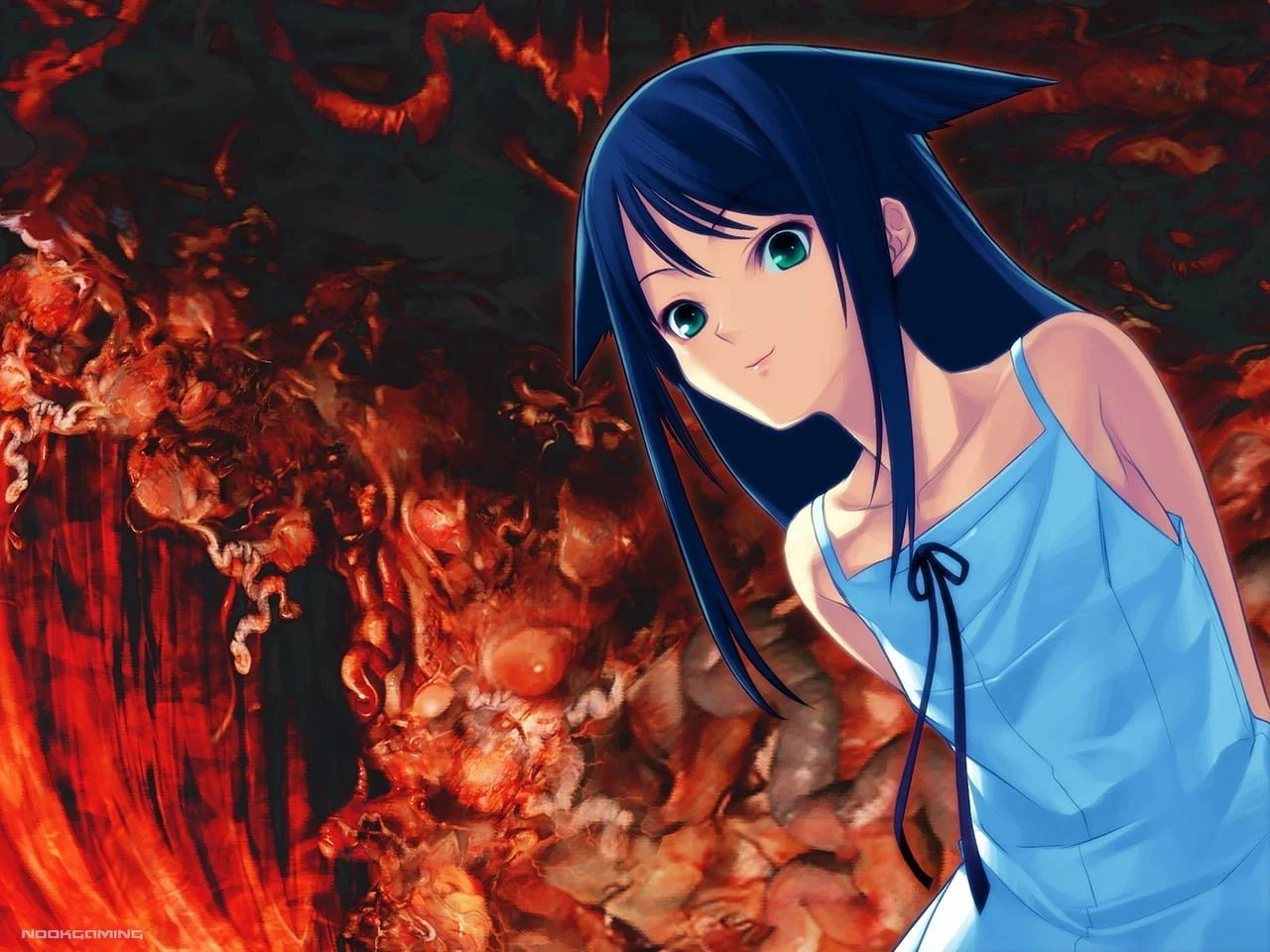 Saya from Song of Saya in a white dress, looking melancholic
Saya from Song of Saya in a white dress, looking melancholic
The Traumatic Incident that Changes Everything
At the heart of Saya no Uta: The Song of Saya is Fuminori Sakisaka, a medical student whose life takes a horrifying turn. A devastating car accident claims his family and leaves him critically injured. Experimental brain surgery becomes his only hope for survival. While the surgery saves his life, it tragically distorts his perception of reality. The vibrant world he once knew is replaced by a nightmarish landscape of flesh and decay. Everything and everyone, including his closest friends, now appear as grotesque masses, a constant assault on his senses.
Isolated and surrounded by these horrifying visions, Fuminori spirals into despair. Suicide seems like the only escape. But in the sterile environment of his hospital room, a beacon of normalcy appears: Saya. Dressed in white, she is the only figure who retains a human form in Fuminori’s warped perception. This encounter marks the beginning of a bizarre and unsettling relationship, as Fuminori clings to Saya, the sole semblance of humanity in his monstrous world.
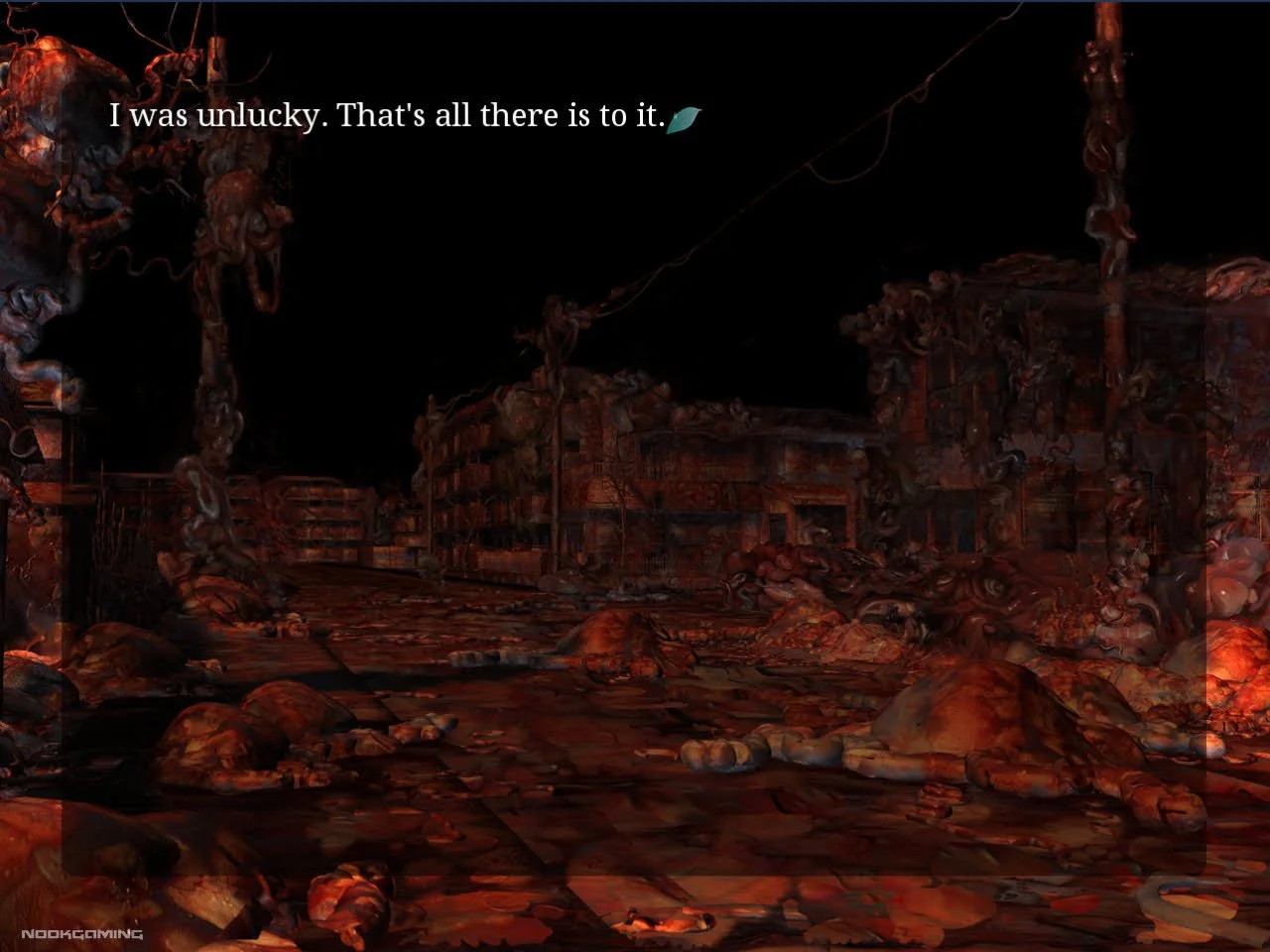 Fuminori and Saya sitting together, Saya looking serene and Fuminori looking conflicted
Fuminori and Saya sitting together, Saya looking serene and Fuminori looking conflicted
Delving into a World of Grotesque Horror
Saya no Uta: The Song of Saya wastes no time in immersing the player in Fuminori’s terrifying reality. The game vividly portrays his surroundings as pulsating flesh, not just visually, but also through descriptions of sickening scents and textures. His friends, once sources of comfort and camaraderie, are now monstrous figures, their words replaced by guttural sounds and their forms oozing with repulsive fluids. The sheer visceral detail of these descriptions is designed to be stomach-churning, effectively conveying the unimaginable horror of Fuminori’s altered perception. It’s a truly unsettling experience to witness the familiar turned into the utterly alien and repulsive.
This shocking introduction sets the tone for Saya no Uta: The Song of Saya. A simple lunch scene with friends transforms into a test of endurance, as Fuminori struggles to maintain composure amidst the grotesque beings that were once his companions. Interestingly, the dominant emotion in these initial scenes isn’t grief or sadness, but rather exhaustion, weariness, and a desperate desire to escape this horrifying existence. This atmosphere of oppressive dread and alienation becomes a defining characteristic of The Song of Saya, as Fuminori is increasingly consumed by the cruelty of his new reality.
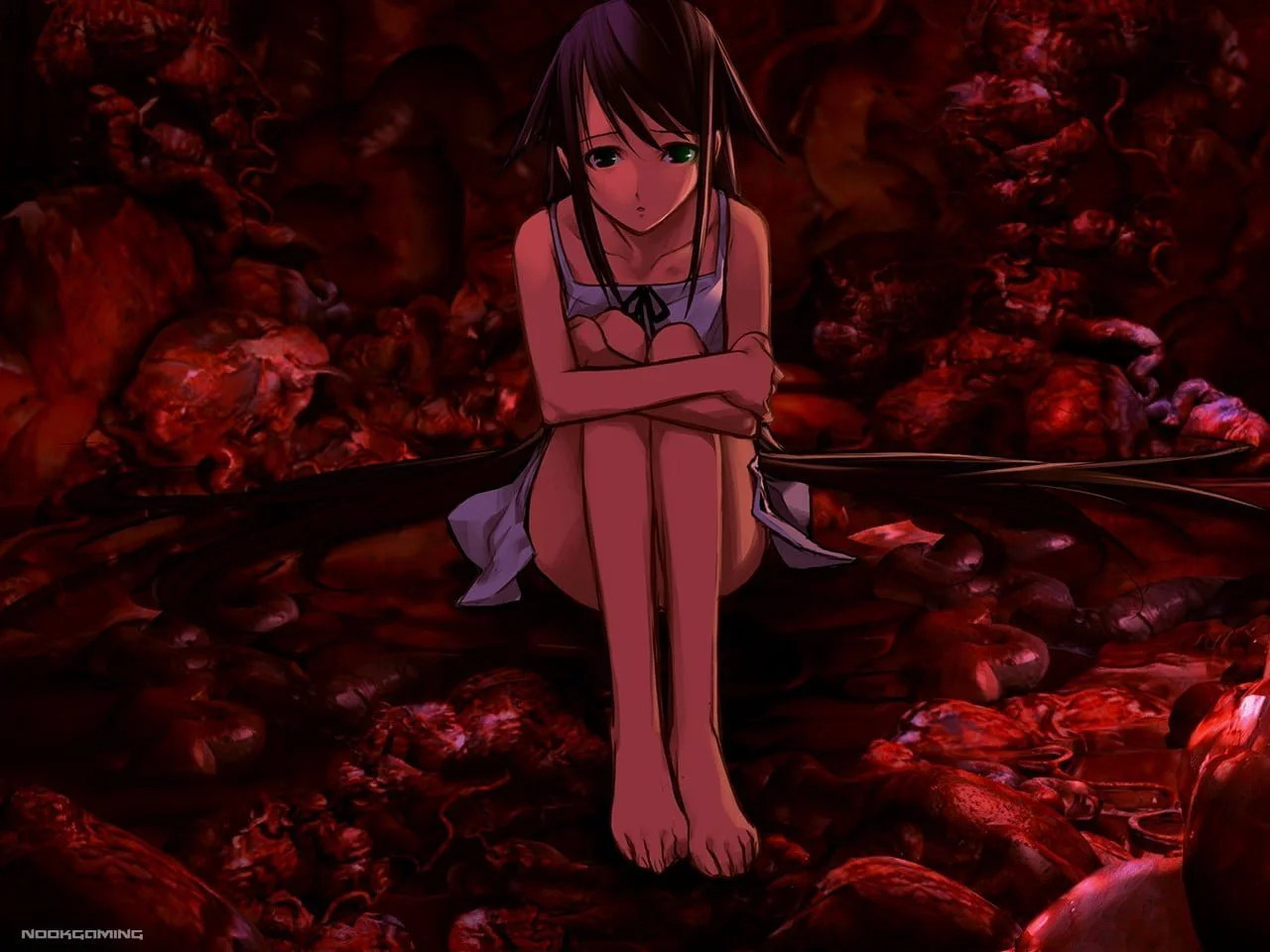 Saya looking downwards with a sad expression, in a dimly lit environment
Saya looking downwards with a sad expression, in a dimly lit environment
Saya: A Beacon of Hope or Something More Sinister?
Saya’s introduction in Saya no Uta: The Song of Saya presents a stark contrast to the nightmarish world Fuminori inhabits. Her innocent appearance and gentle demeanor make her stand out even more dramatically against the backdrop of pulsating flesh and monstrous forms. In a world defined by horror, Saya appears as an anomaly, a figure of pure innocence. This deliberate juxtaposition immediately raises questions about her true nature and purpose within the narrative. Saya no Uta: The Song of Saya is not a lighthearted romantic comedy, so Saya’s presence hints at a deeper, perhaps more sinister, layer to the story.
This jarring contrast is what elevates Saya no Uta: The Song of Saya beyond typical horror media. Saya isn’t just a source of shock value; she embodies a flicker of hope for Fuminori. In his distorted reality, she represents everything he has lost – normalcy, human connection, and beauty. The possibility of regaining these through Saya is incredibly compelling and emotionally resonant for Fuminori, and for the reader experiencing the story through his eyes. It initially seems like a heartwarming tale of finding solace in darkness, but the psychological horror tag serves as a constant reminder that something is deeply amiss.
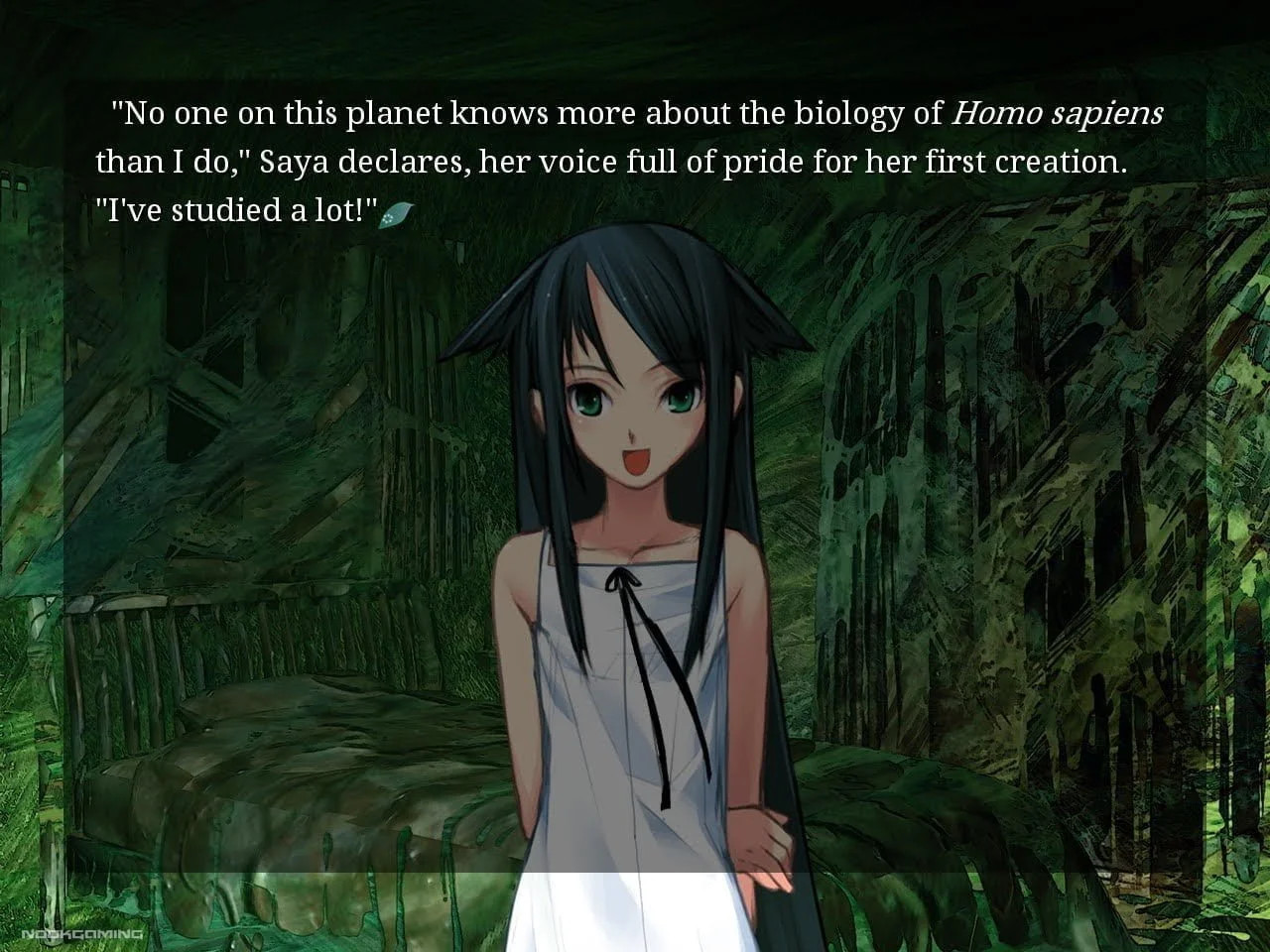 Close up of Saya's face, looking directly at the viewer with a slight smile
Close up of Saya's face, looking directly at the viewer with a slight smile
Unraveling Saya’s Enigma
Beyond Fuminori’s personal torment, the central mystery of Saya no Uta: The Song of Saya revolves around Saya’s identity. The dissonance between Saya’s apparent humanity and the monstrous world around her is impossible to ignore. She appears in the hospital late at night, when visitors are prohibited. She exudes a pleasant scent and feels soft to the touch, offering comfort and normalcy. Meanwhile, Fuminori’s friend Tsukuba You, a conventionally attractive woman in his past perception, is now a revolting mass of flesh. This discrepancy applies to everyone Fuminori encounters; only Saya retains her human form in his eyes.
Saya’s unique existence injects a layer of unsettling complexity into her seemingly innocent interactions with Fuminori. Their relationship, while romantic on the surface, gradually becomes imbued with a sense of unease. A creeping sense of dread builds as the narrative progresses, hinting at hidden truths lurking beneath the surface of Saya’s persona. Why is Saya the sole human figure in Fuminori’s world? What secrets does she conceal beneath her white dress? These questions become increasingly urgent as the story unfolds, driving the narrative forward and deepening the psychological horror.
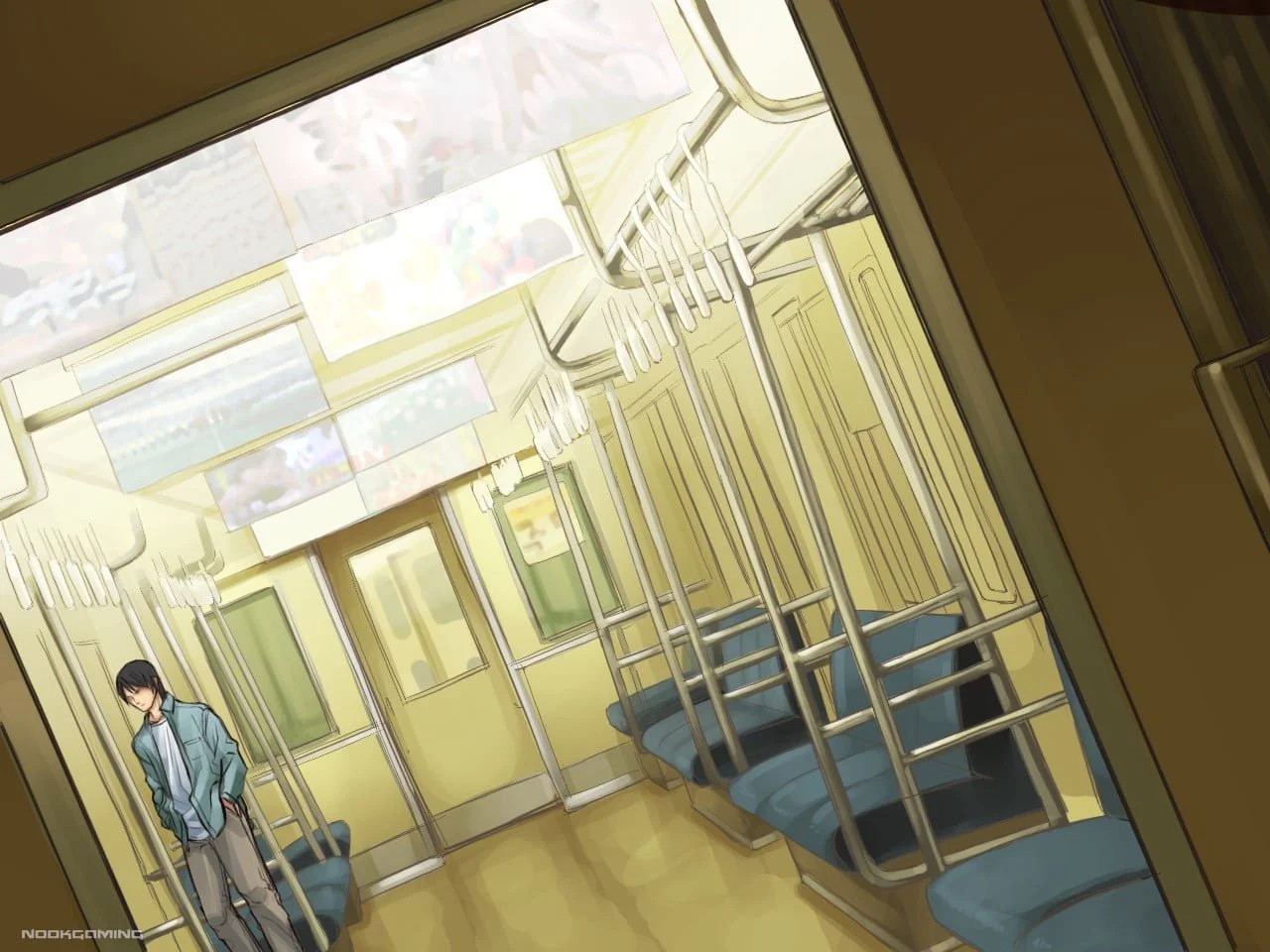 A dark train car with dim lights and a figure in the distance, hinting at isolation and mystery
A dark train car with dim lights and a figure in the distance, hinting at isolation and mystery
A Focused and Intense Narrative
With an average playtime of around 6 hours, Saya no Uta: The Song of Saya maintains a brisk pace, efficiently utilizing its runtime. The narrative forgoes typical slice-of-life filler often found in other visual novels. Within the first hour, hints of Saya’s true nature begin to surface, piecing together the puzzle of her identity. The game provides little respite, constantly propelling the story towards its inevitable and disturbing conclusion. There’s a deliberate lack of breathing room, mirroring Fuminori’s own suffocating reality.
However, this tight pacing works to the game’s advantage. Saya no Uta: The Song of Saya centers on a small cast of characters, avoiding unnecessary introductions that would dilute the narrative focus. The core players are established early on, allowing the story to delve deeply into their relationships and motivations. Despite its intense and rapid progression, The Song of Saya feels remarkably cohesive and self-contained. By sacrificing a sprawling setting, the game prioritizes character development and the exploration of their increasingly disturbing choices.
The narrative effectively employs multiple points of view (POVs) to illuminate the unfolding tragedy of Fuminori and Saya’s relationship. As their decisions become increasingly morally ambiguous and unsettling, the POVs shift to other characters, forcing the reader to confront the wider consequences of their actions. This narrative technique amplifies the emotional impact, culminating in a powerful and disturbing climax when these perspectives converge, making Saya no Uta: The Song of Saya a profoundly impactful experience.
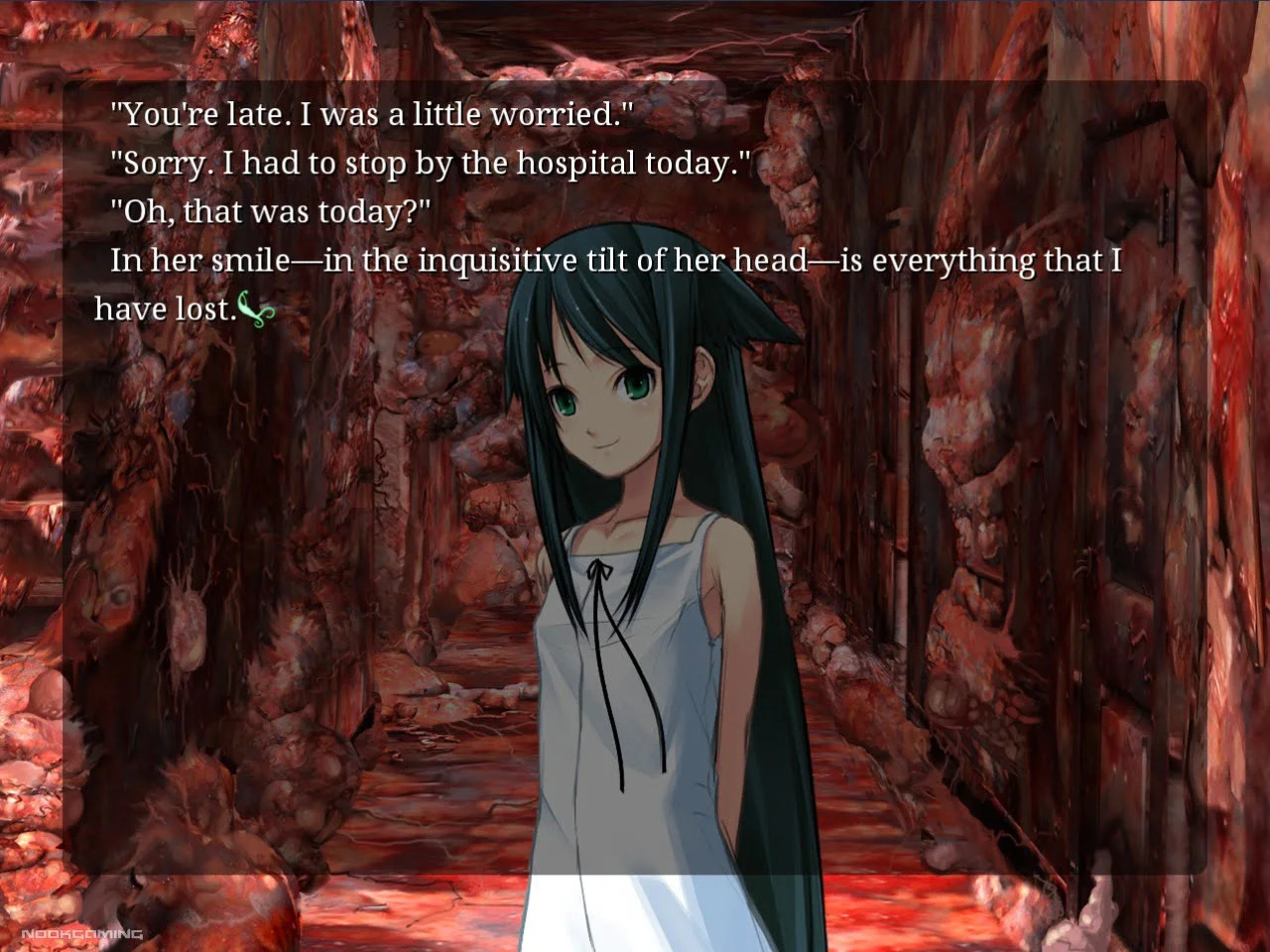 Close up of a character's face in dialogue, expressing intense emotions
Close up of a character's face in dialogue, expressing intense emotions
Exploring the Depths of Insanity and Perception
Insanity is a central theme in Saya no Uta: The Song of Saya. The game constantly questions the nature of reality, as Fuminori’s perception diverges so drastically from the norm. Choices presented throughout the game explicitly challenge the player to define what is “normal” and what is not, directly influencing the narrative and leading to one of three distinct endings. This exploration of subjective reality and sanity becomes increasingly unsettling as characters make choices that venture further into the abnormal.
The use of multiple POVs in Saya no Uta: The Song of Saya becomes crucial in exploring this theme of insanity. As Fuminori embraces his relationship with Saya, his perception of normalcy warps to align with his monstrous reality. Conversely, characters outside of Fuminori’s perspective, who perceive the world as “normal,” are confronted with the abnormal through their connection to him. This clash between differing worldviews – Fuminori and Saya’s distorted reality versus the conventional status quo – drives the horrific events of the story.
This descent into madness is masterfully paced and executed. The narrative effectively conveys the desperation, fear, and anxiety that gnaw at the characters’ psyches, making the story deeply unsettling yet compelling. The reader witnesses each character grapple with the disintegration of their reality in unique ways, evoking a complex tapestry of emotions: sadness, disappointment, and even anger. It’s a gradual, insidious process, drawing the reader into the characters’ unraveling sanity.
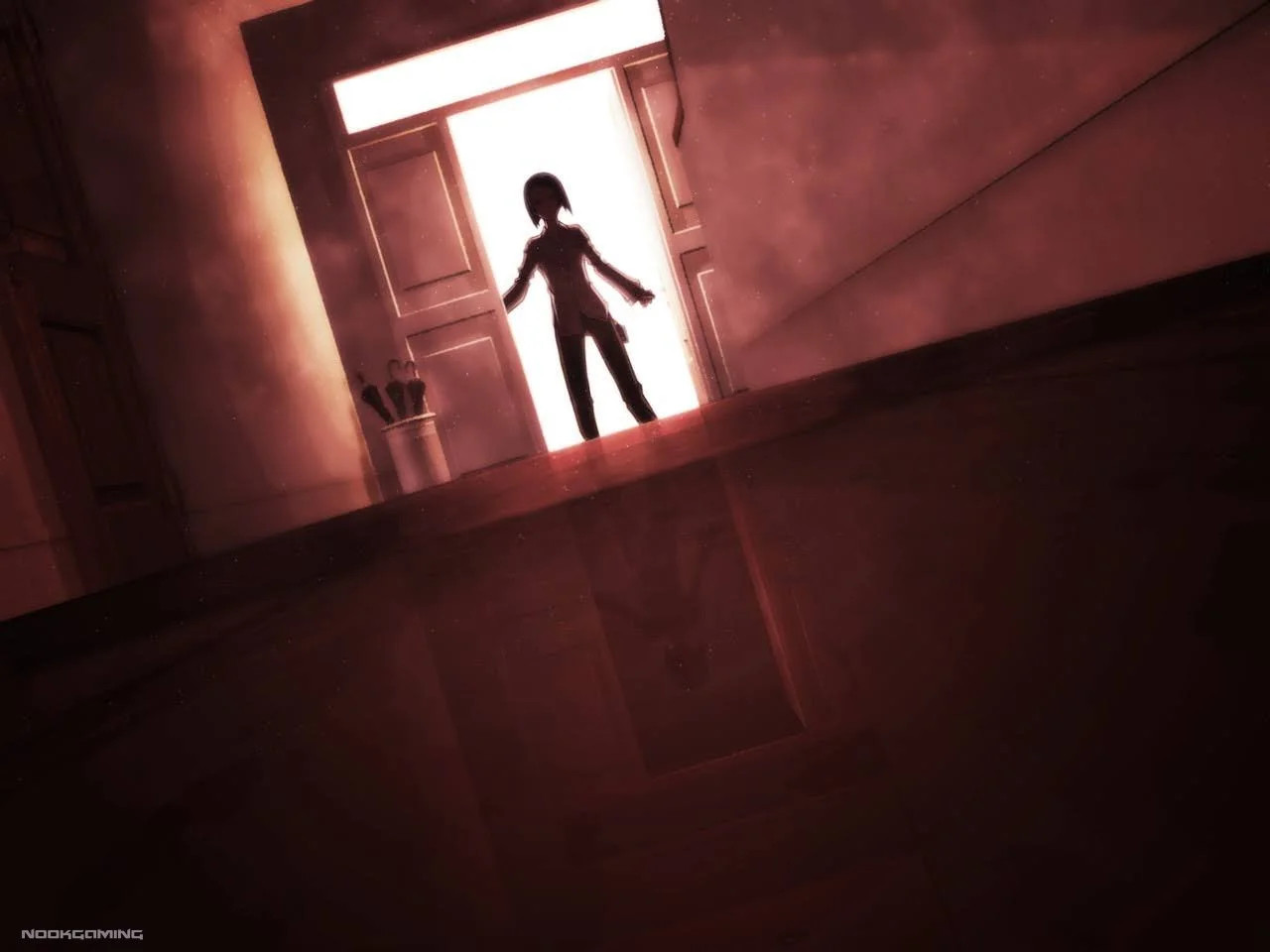 A dimly lit corridor with a figure at the end, creating a sense of unease and suspense
A dimly lit corridor with a figure at the end, creating a sense of unease and suspense
Adult Content and Narrative Purpose
Saya no Uta: The Song of Saya is available in both censored and uncensored versions. The Steam release is censored, but a patch is available to restore the adult content. The inclusion of explicit sexual content in a horror visual novel naturally raises questions about its necessity. While horror often utilizes sex to depict intimacy and vulnerability, heightening the impact of loss and violence, Saya no Uta: The Song of Saya uses it for a more nuanced narrative purpose.
In Saya no Uta: The Song of Saya, adult content serves to further reveal Saya’s true nature. The sexual encounters are intrinsically linked to her biology and alien origins. While the game subtly hints at these aspects even outside of explicit scenes, the adult content undeniably adds another layer of understanding to Saya’s character and her relationship with Fuminori. While the story remains impactful even without the adult content, its inclusion provides a deeper, albeit disturbing, dimension to the horror and Fuminori’s increasingly warped perception of love and intimacy. For those with a strong aversion to such content, skipping the patch may be preferable, but for those who can stomach it, it undeniably enriches the narrative experience.
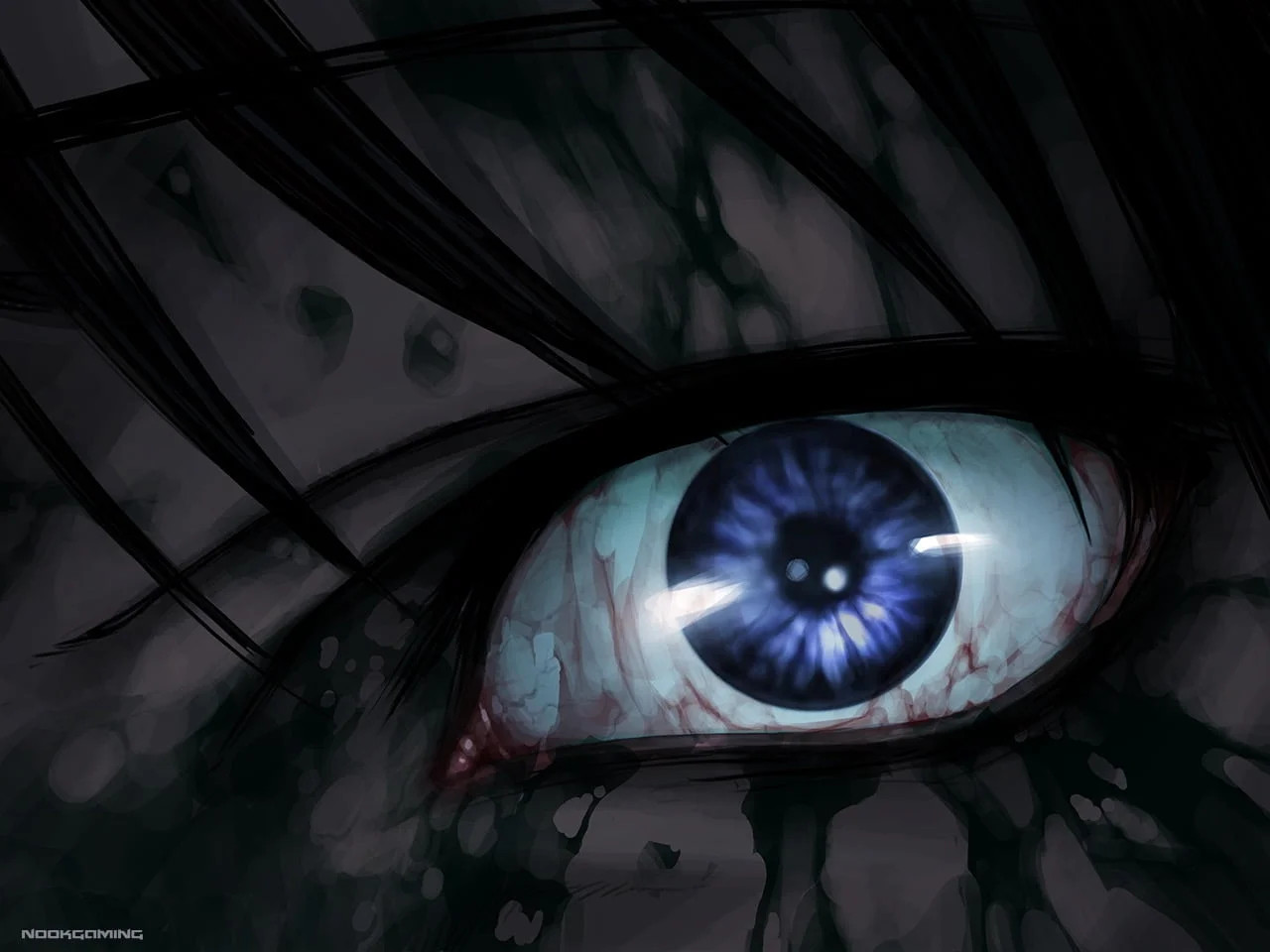 A close-up of an eye, possibly symbolizing distorted perception and horror
A close-up of an eye, possibly symbolizing distorted perception and horror
Striking Art and Haunting Music
The visual style of Saya no Uta: The Song of Saya, crafted by Chuuou Higashiguchi, is reminiscent of classic Nitroplus titles like Kikougai – The Cyber Slayer and Deus Machina Demonbane. The artwork emphasizes realism in character expressions, conveying emotion without resorting to exaggeration. Characters are rendered with a raw, grounded aesthetic, making them feel relatable despite the fantastical horror elements.
However, Saya no Uta: The Song of Saya also doesn’t shy away from depicting graphic and disturbing imagery. Some scenes feature incredibly grotesque visuals, showcasing monstrous forms and unsettling bodily details. This graphic art style powerfully complements the vivid textual descriptions, amplifying the game’s sensory horror and immersing the player in Fuminori’s nightmarish world. Recognizing the potentially upsetting nature of these visuals, the game thoughtfully includes options to reduce visibility and censor certain aspects of the artwork, allowing for a more personalized and less overwhelming experience.
The soundtrack of Saya no Uta: The Song of Saya, comprising fifteen tracks, is equally integral to the game’s atmosphere. Each piece effectively evokes specific emotions and scenes, enhancing the reading experience significantly. Themes of dread, guilt, malice, and sorrow permeate the music, creating a haunting and unsettling soundscape that perfectly complements the psychological horror of the narrative. The music lingers in the mind long after finishing the game, testament to its evocative power and contribution to the overall experience.
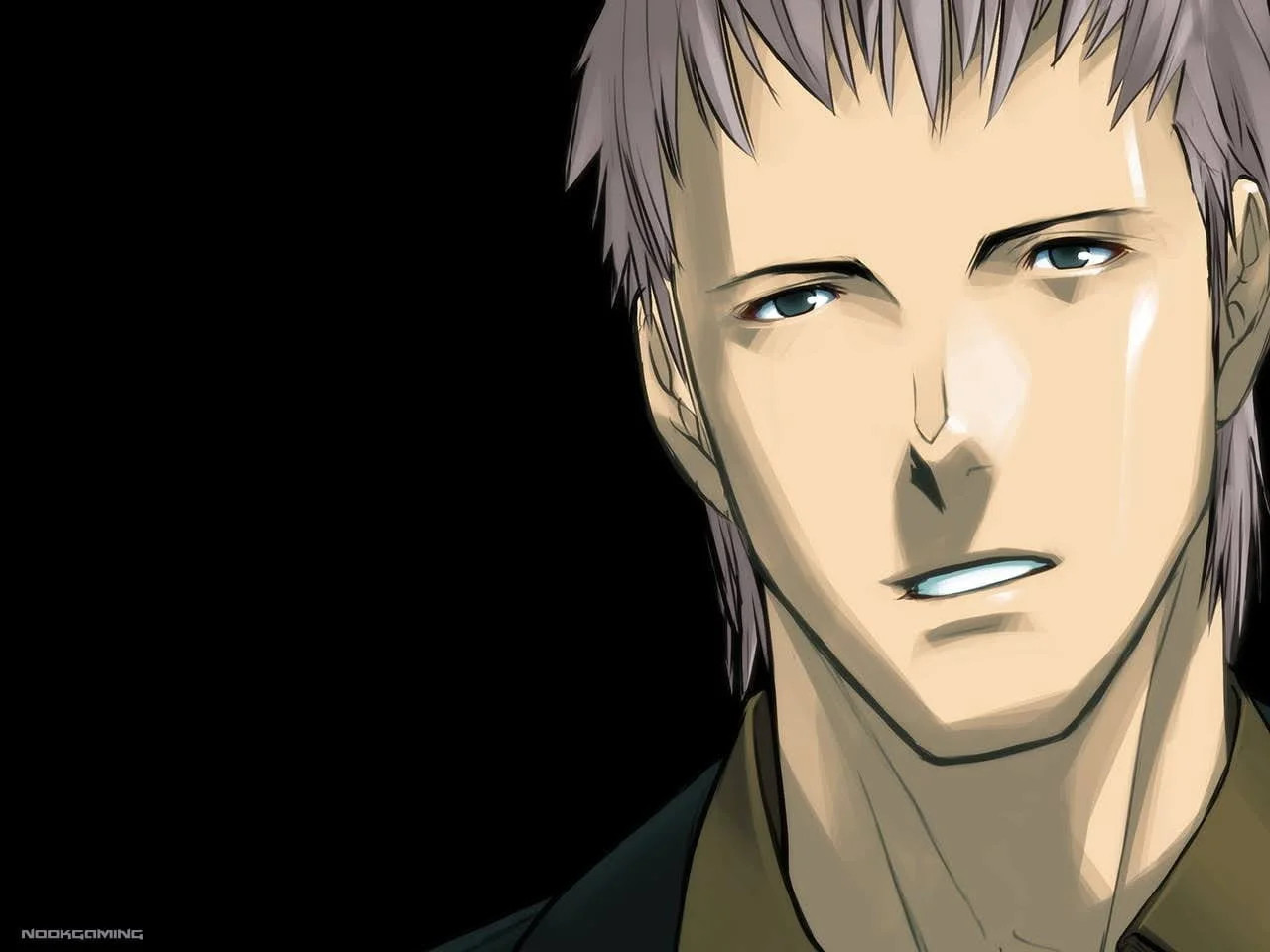 Saya standing in a field of flowers, a stark contrast to the grotesque world, yet still unsettling
Saya standing in a field of flowers, a stark contrast to the grotesque world, yet still unsettling
Final Verdict: A Must-Experience Horror Visual Novel
Saya no Uta: The Song of Saya is a remarkable and disturbing deconstruction of the boy-meets-girl romance trope. Its grotesque imagery and subtle psychological horror elements create a truly unforgettable experience. Rather than relying on cheap jump scares, The Song of Saya cultivates a deep-seated psychological fear through its narrative, character interactions, and unsettling atmosphere. It masterfully leaves much of the horror to the player’s imagination, amplifying its impact. While its singular focus on the core narrative may sacrifice a broader, more detailed world, the intense character development and exploration of its central themes more than compensate for this.
Ultimately, Saya no Uta: The Song of Saya is an exceptional visual novel, offering a uniquely disturbing and thought-provoking experience, regardless of whether you choose to include the adult content. It is highly recommended for those with the fortitude to confront its challenging themes and unsettling imagery.
THE SONG OF SAYA IS HIGHLY RECOMMENDED
Platforms: PC Purchase: JAST
Looking for more unsettling visual novels? Explore our review of The Shell Part I: Inferno.
For more articles like this, follow us on Twitter🐦 and enable notifications. Join our Discord community to chat with us.
Support Quality Content
Enjoying our in-depth articles? Support us by buying us a coffee on Ko-fi! Check out our shop for digital goodies too!
John Rafael
Visual novel enthusiast, gacha gamer, TCG player, and VTuber fan. Always seeking new stories and experiences.


